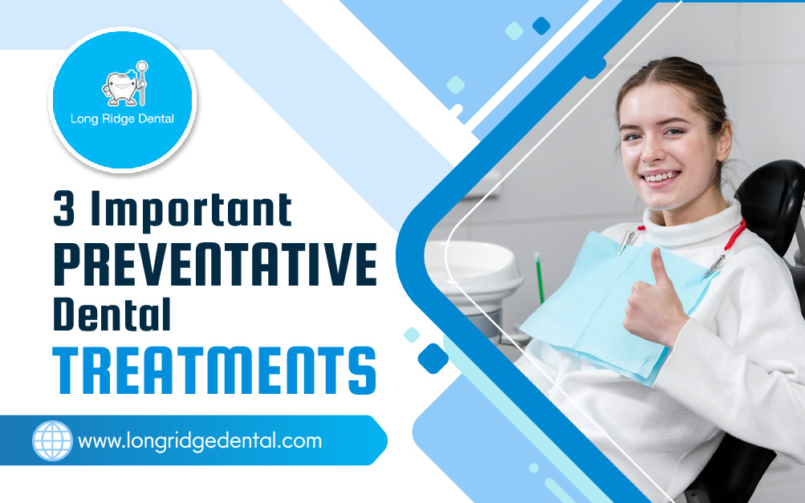
3 Important Preventative Dental Treatments
Around 92% of adults aged 20-64 carry dental cavities. The common reason for this high ratio is delaying preventive dental care. Not only in adults but early childhood cavities (ECC) is the most common chronic disease in kids.
Regular preventive dental appointments with your dentist not only help promote healthy teeth growth and diagnose early disease symptoms.
Why is Prevention So Important?
Diagnosing oral issues at the early stage has a higher chance of curing the cause. Regular preventive dental care helps prevent potential problems.
The dentist will examine early tooth decay or gum disease signs during regular checkups. Around 47.2% of adults suffer from potential oral diseases. Why? Because they delayed the checkups and preferred visiting the dentist when there was a need. Kids are showing an ever-increasing ratio of dental cavities.
Keep examining your oral health and look for early symptoms. If you see swelling or bleeding gums, immediately consult your dentist for treatment.
3 Essential Preventive Dental Care Treatments
Professional dentists recommend the below-mentioned dental treatments, which are must-haves for all age groups.
Sealants:
No matter how often you stop your kids from eating junk, you will find them eating sweets, candies, and chocolates at the end of the day. Of course, extra sweetness causes cavities. 90% of children’s back molars have tooth cavities- the most common chronic pediatric problem in children.
Sealant is preventive dental care that protects the chewing surface from cavities. A protective shield covers the top of the teeth that block out food and germs.
Dental sealant is recommended for the age group of 6-14. Permanent molars break by the age of six and second appear by the age of 12. The best part about a sealant is it is a painless treatment and way better than filling cavities.
The process of a dental sealant is as under;
- First, the teeth are cleaned, then a gel layered is applied on the chewing surface.
- After a few seconds, the teeth are cleaned and dried.
- The dentist will now print the sealant layer on the chewing surface and use ultraviolet light to dry and harden the coat.
- Prevent eating or drinking for at least an hour.
Fluoride Treatment:
Just like vitamins, minerals are also crucial for the body. Calcium, along with phosphorus, works to bolster the tooth enamel. The deficiency of calcium from the diet causes tooth decay. The frequent tooth enamel causes cavities and other oral damage. That is when fluoride saves the teeth.
Sometimes fluoride toothpaste is not enough to keep the teeth strong and healthy. Fluoride treatment secures the teeth from demineralization and averts bacterial growth that deteriorations the teeth and causes cavities.
Fluoride treatment is a one-time preventive dental care that saves you from expensive oral treatments and procedures. Here is how the fluoride treatment is done;
- The dentist cleans your teeth and dries them before applying the gel layer.
- A highly-concentrated gel layer is applied to the teeth with the help of a brush or swab.
- The gel will take a few minutes to dry.
- You will be asked to evade drinking or eating for at least 30 minutes.
Oral Cleaning:
The last preventive dental care option we have here is teeth cleaning. Daily brushing is insufficient to maintain oral hygiene and keep the teeth and gums healthy. After every six months, it is recommended to undergo teeth cleaning.
The dentist uses special tools to remove the plaques and deposited tartar from the teeth’ surface. This deep cleaning prevents gum diseases, cavities, tooth decay, and tooth loss.
Here is how oral teeth cleaning works;
- The dentist will first physically examine the teeth and gums and look for any sign of disease.
- The dentist will then use a scaler to remove the deposited tartar and plaque.
- After removing the tartar, the dentist will perform expert brushing and flossing with an electric toothbrush.
- A polished coat will be applied at the end to give a shiny bright look.
How Often Should You Visit The Dentist?
According to the basic rule of thumb, you should visit your dentist every six months. However, it also depends on your oral health. If your oral health is up-to-mark, visiting the dentist once a year will be acceptable.
Contrary, if you have oral issues, it is recommended to visit a dentist every 3-4 months. Delaying the checkup will give you nothing but worsen the condition. Give priority to your health and visit your dentist whenever you feel a need.
Doctors didn’t lie when they said prevention is better than cure. Those mentioned above preventive dental care treatments are a must to have every six months. These treatments will not promote healthy teeth growth but also save you from long-term dental diseases. Ensure to visit a dentist every six months to maintain your oral health.
You must be logged in to post a comment.